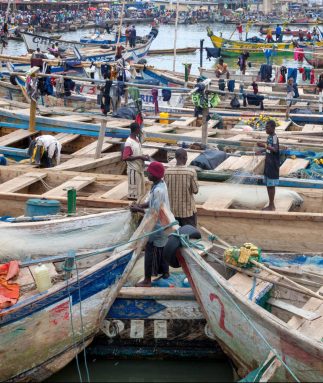Dumping fish in the country’s seas ranks among the highest in the Gulf of Guinea, says a report by the Environmental Justice Foundation (EJF).
The report, titled ‘On the precipice: Crime and corruption in Ghana’s Chinese-owned trawler fleet’ and published in December 2022, noted that despite the practice being explicitly outlawed, the phenomenon is constantly on the rise.
Section 32(1) (a) of the Fisheries Regulations 2010 (LI 1968) states that “a person fishing under the authority of a licence issued for commercial fishing in Ghana shall not dump, from any vessel, fish that has been caught which is suitable for human consumption”.
In spite of this, the EJF in its report disclosed that the practice remains highly prevalent as captains order the discarding of low-value, often juvenile, fish to make space for more valuable species.
“The fish that are dumped are often species targetted by canoe fishers, and are dead by the time they are returned to sea. The amount of fish dumped can depend on the time of year,” the report noted.
According to EJF, 92 percent of crew members interviewed on vessels said that they had witnessed the dumping of fish at sea.
“A fisheries observer estimated that on one recent trip, nearly 50 tonnes of fish was dumped over a period of approximately 45 days at sea. Interviewees reported that captains would often encourage crew to haul in a new catch of fish before they were able to sort the previous one – meaning that all remaining fish on the deck would be dumped,” the document said.
One interviewee, according to the organisation, reported: “[We are] dumping fish too much. Sometimes you can get the fish and the boat will be full, but they will still haul the net”.
The issue of fish discarding, according to EJF, has become worse since the ending of at sea ‘saiko’ trans-shipments.
Previously, economically undesirable fish would be frozen and sold to saiko canoes; allowing the industrial vessels to fill their holds with higher value species while simultaneously generating profit from saiko.
Now without the saiko canoes as an outlet for these fish, crew members are instructed to simply dump them overboard.
Data from the EJF says West Africa holds significant importance for the Chinese DWF, with its bottom trawl fleet catching an estimated 2.35 million tonnes of fish in the region annually; valued at over US$5billion.
A spatial analysis by EJF of over 550 suspected Illegal, Unreported and Unregulated (IUU) fishing incidents linked to the Chinese DWF found that West Africa, and specifically Ghana, leads among regions in which the highest instances of illegal fishing were identified.
Ghana has already received two yellow-cards within the framework of the EU IUU Regulation, indicating a warning that it may be listed as failing to take sufficient actions to prevent, deter and eliminate IUU fishing (known as a red-card).
Although the first yellow-card – which was given in 2013 – was rescinded in 2015, the country became one of only two countries to receive a second yellow-card in 2021 for again failing to cooperate in the fight against IUU fishing.
This development indicates how embedded illegality is within the fishery industry, and the collective failure of Ghanaian authorities to suitably tackle its root-causes to drive lasting change.


















